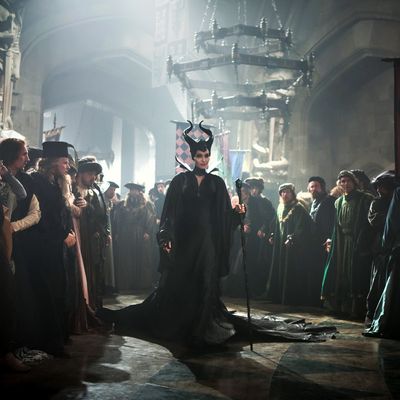
The first thing we have to acknowledge is that Angelina Jolie is an excellent choice to play Maleficent, the evil sorceress from Sleeping Beauty who casts the spell of eternal slumber on Princess Aurora. And in Robert Stromberg’s part prequel, part revision, she gets a chance to expand the dynamic range of this haunting villain: She doesn’t just cackle and snarl, but she also cries, gets hurt, and has changes of heart. And she’s not really the bad guy anymore. When we first meet Maleficent, she’s a cherubic young girl with wings (and those telltale horns), happily relaxing in a tree in the Moors, the kingdom of free and magical spirits who live right next to the royalty-bound kingdom of humans. One day, a young human thief named Stefan steals into the Moors, and he and Maleficent strike up a friendship. His iron ring burns her skin, and he removes it so he can touch her – a gesture that strikes her as exceedingly romantic. It’s an elegant and proper irony: The fairy tale character most committed to the destruction of true love turns out to have been one of its early victims.
Stefan and Maleficent’s friendship eventually meets with betrayal. They’ve become adults, on opposing sides of a war. The dying king of the humans wants to conquer the Moors, and he promises his throne to whoever can kill Maleficent and bring her wings back as a trophy. So Stefan drugs his beloved, cuts her wings, and seizes the throne. That’s right, it turns out the real bad guy was King Stefan — Sleeping Beauty’s father. Maleficent, rocked by his cruelty, retreats back into her world and turns the Moors into a dark, blasted, hellish landscape — sheltered by a forest of thorns, guarded by tree-root warriors and dragons made of dirt. The effects are gorgeous, even if they signal something tragic — the transformation of one of the great fairy tales into another zillion-dollar world-building exercise. At least they could have kept the Tchaikovsky. (Lana Del Rey’s rendition of the classic song “Once Upon a Dream,” based on Tchaikovsky’s ballet, does play over the end credits. But by that point, the damage is done.)
After that, the film briefly settles into a re-creation of that original, primal moment from the fairy tale and the Disney classic. The uninvited Maleficent crashes the party of the baby’s christening and puts a curse on the child: The girl will prick her finger on a spinning needle on her 16th birthday, and die — a curse soon revised to merely an eternal sleep, until true love’s kiss awakens her. But the story takes a wildly different route from there. As before, three kindly fairies take Princess Aurora under their wing and hide her in the woods for the next 16 years. But Maleficent isn’t easily fooled; she finds them instantly. Indeed, it’s our beloved villain — starting to look more and more like a heroine — who winds up secretly feeding the child and rocking her to sleep while the three incompetent fairies bicker and goof around. “I hate you,” Maleficent says to the baby early on, in perfect deadpan; as the tot smiles back at her; we know right then that there’s no way she will not grow to love this child. Sure enough, as Aurora grows up (and is played as a teen by Elle Fanning), the sorceress who had foresworn off love and children and all those beautiful things now realizes she has a soft spot for them. She begins to regret her curse. Of course, those of us who’ve seen Frozen (which I guess is all of us, at this point) know that true love need no longer mean what we used to think it means.
I’ve probably already said too much, but it’s kind of hard not to when discussing what kind of film Maleficent is. In undercutting and reversing her villainy, Stromberg and screenwriter Linda Woolverton (who wrote both the wonderful Lion King and the ghastly Tim Burton version of Alice in Wonderland, by the way) do find an intriguing new way into the story. But they’re a bit too enamored of their revisionism, and they don’t quite know what to do with the rest of the tale. Elsewhere, I’ve argued that we’ve lost something with Disney’s move away from traditional villains in their more recent movies. Maleficent provides a good example: In robbing Maleficent of her cruelty, the film doesn’t really reject the notion of evil — it merely transfers it to King Stefan (played as an adult by District 9’s Sharlto Copley). And he, alas, is a peculiarly uncharismatic fellow, more a delusional and feckless tyrant than somebody whose actions can fuel the elemental terrors and emotions of a fairy tale. Singularly unthreatening, he doesn’t seem worthy of the betrayal Maleficent feels, nor does he seem worthy of the battle she later wages.
Princess Aurora is served even worse. Fanning is one of our great young actresses, but there’s little here for her to do except smile and look on naïvely. Maybe that’s part of the joke — Sleeping Beauty herself relegated to a glorified bit-part in her own story — but it’s hard to buy Maleficent’s transformation and redemption if Aurora doesn’t come alive for us in some way. Jolie’s commitment to the part is admirable: She gives this Maleficent a real emotional urgency. But the rest of the movie lets her down.


